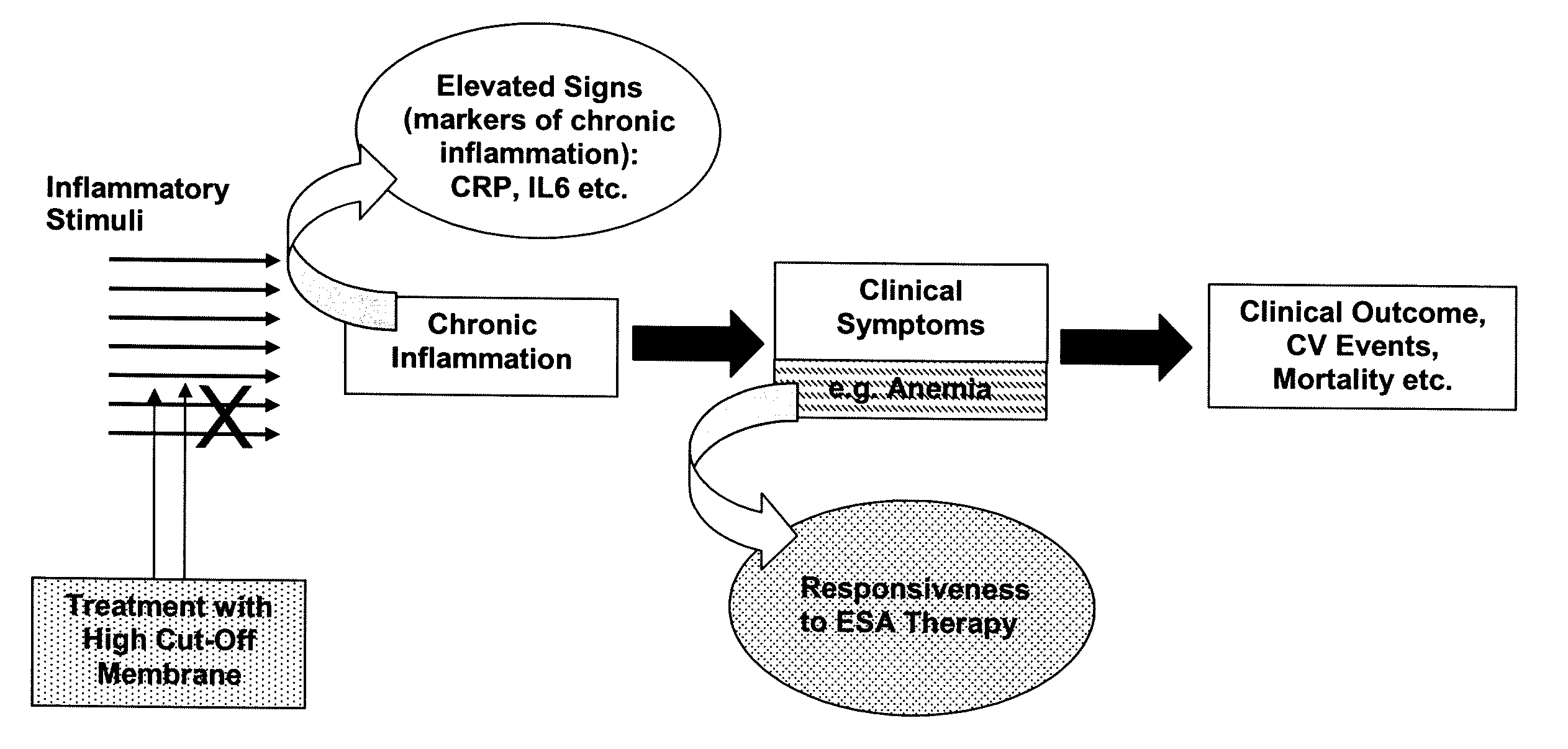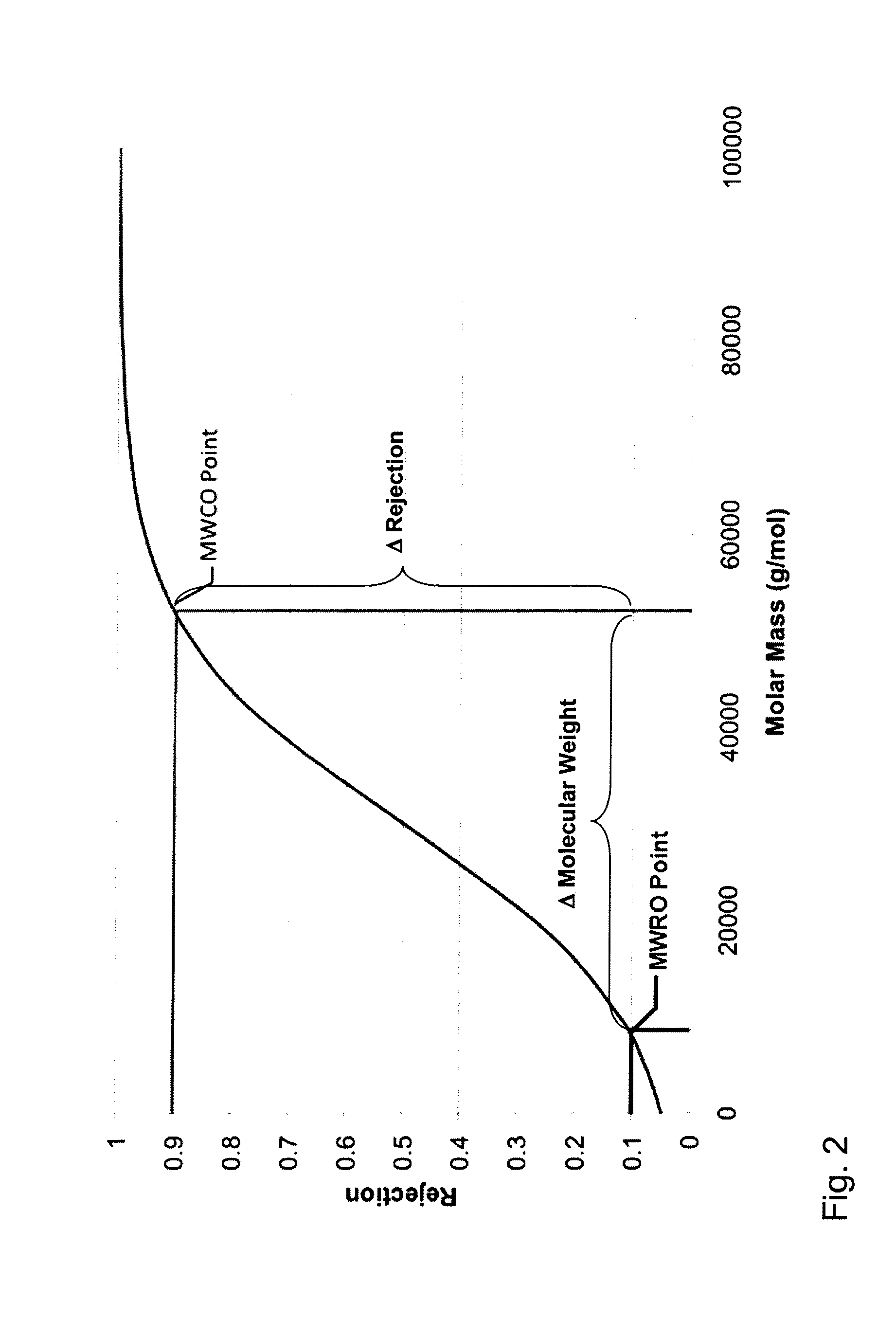Method for Treating Anemia in Hemodialysis Patients
a hemodialysis patient and anemia technology, applied in the field of high-cutoff hemodialysis membrane for the treatment of anemia in hemodialysis patients, can solve the problems of severe clinical consequences for hemodialysis patients, lack of oxygen in the tissues and organs of the body, and worsening of anemia in patients' sta
- Summary
- Abstract
- Description
- Claims
- Application Information
AI Technical Summary
Benefits of technology
Problems solved by technology
Method used
Image
Examples
example 1
Membrane Preparation
[0107]Two solutions are used for the formation of the membrane, the polymer solution consisting of hydrophobic and hydrophilic polymer components (21 wt-%) dissolved in N-methyl-pyrrolidone, and the center solution being a mixture of N-methyl-pyrrolidone and water. The polymer solution contains polyethersulfone (PES 14.0 wt-%) and polyvinylpyrrolidone (PVP 7.0 wt-%) as membrane building components. The solution further contains NMP (77.0 wt-%) and water (2.0 wt-%). The center solution contains water (53.0 wt-%) and NMP (47.0 wt-%).
[0108]During the membrane formation process polymer and center solution are brought in contact with a spinneret or jet and the membrane precipitates. A defined and constant temperature (58° C.) is used to support the process. The precipitated hollow fiber falls through a humidified shaft filled with steam (100% relative humidity, 54° C.) into a washing bath (20° C., ˜4 wt-% NMP). The membrane is further washed in two additional water ba...
example 2
Preparation of Hand Bundles and Mini-Modules
[0110]The preparation of a membrane bundle after the spinning process is necessary to prepare the fiber bundle for following performance tests. The first process step is to cut the fiber bundles to a defined length of 23 cm. The next process step consists of melting the ends of the fibers. An optical control ensures that all fibers are well melted. Then, the ends of the fiber bundle are transferred into a potting cap. The potting cap is fixed mechanically and a potting tube is put over the potting caps. Then the fibers are potted with polyurethane. After the polyurethane has hardened, the potted membrane bundle is cut to a defined length and stored dry before it is used for the different performance tests.
[0111]Mini-modules [=fiber bundles in a housing] are prepared in a similar manner. The mini-modules ensure protection of the fibers and are used for steam-sterilization. The manufacturing of the mini-modules comprises the following specif...
example 3
Dextran Sieving Coefficients
[0113]Dextran sieving coefficients are being determined according to the following method. The Sieving Coefficient (SC) is calculated according to the following equation:
SC=2×CFCBin+CBout[%],
wherein CF is the concentration of the solute in the filtrate, CBin is the concentration of a solute at the blood inlet side (feed) of the device under test, and CBout is the concentration of a solute at the blood outlet side (retentate) of the device under test. The determination of the sieving coefficients of a given device follows Scheme I below:
[0114]GPC, gel permeation chromatography, is a type of size exclusion chromatography that separates analytes on the basis of size. The technique is often used for the analysis of polymers. The calibration of the molecular weight versus the retention time is done with a number of dextran standard molecules. The analysis of the chromatograms is done with GPC software, e.g. PL Caliber™ GPC / SEC Software (Version 4.04) of Polyme...
PUM
 Login to View More
Login to View More Abstract
Description
Claims
Application Information
 Login to View More
Login to View More - R&D
- Intellectual Property
- Life Sciences
- Materials
- Tech Scout
- Unparalleled Data Quality
- Higher Quality Content
- 60% Fewer Hallucinations
Browse by: Latest US Patents, China's latest patents, Technical Efficacy Thesaurus, Application Domain, Technology Topic, Popular Technical Reports.
© 2025 PatSnap. All rights reserved.Legal|Privacy policy|Modern Slavery Act Transparency Statement|Sitemap|About US| Contact US: help@patsnap.com



